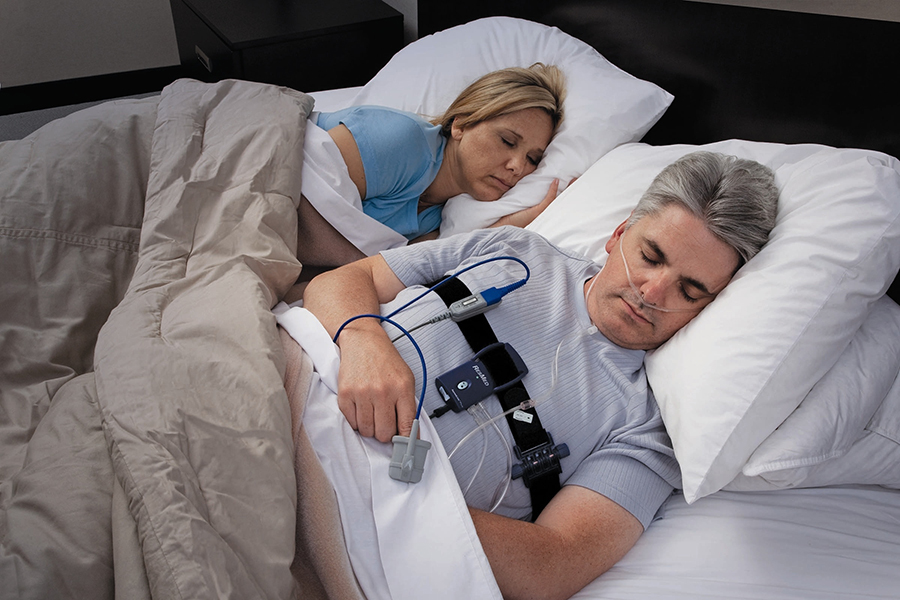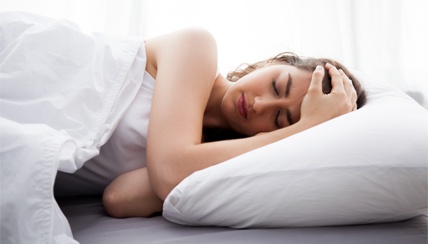If your doctor suspects you have obstructive sleep apnea (OSA), they’ll likely recommend you have a sleep study conducted to diagnose the disorder properly. To determine the diagnosis, there are two primary types of sleep study tests: a polysomnogram (PSG) where you’re supervised by a sleep technologist and a home sleep apnea test (HSAT) where you take the test in the comfort of your own home.
Here, we’ll be addressing the home sleep apnea test or HSAT, specifically the Type III HST.
What is a Home Sleep Test?
Let’s explore further the HSAT:
Home Sleep Study Definition
The HSAT — also called portable monitoring or an out-of-center sleep test, is a diagnostic test sleep professionals and doctors use to diagnose obstructive sleep apnea. OSA is a condition characterized by upper airway obstruction that reduces inspiratory airflow during sleep or repeated episodes of apnea. It’s evolved as a convenient alternative to the traditional overnight in-laboratory attended polysomnography in certain patients.
The HSAT records:
- Chest movement (effort)
- Airflow (breathing)
- Snoring
- Sleeping position
- Oxygen saturation
- Heart rate
It allows sleep medicine specialists to identify times when you have shallow breathing that causes a decline in your oxygen levels or times when you stop breathing.
Type III: Home Sleep Study
The type III HST includes some measurements to collect data like the typical nocturnal polysomnogram (NPSG), but not all. It doesn’t record data to identify disruptions to sleep or sleep stages, but rather it can measures things like:
- Airflow
- Respiratory effort
- Blood oxygen saturation
- Cardiac data
In some cases, this test may also include measurements for snoring, body position and/or light detection. It’s the more common type of HSAT.
The creation of the HSAT was to help doctors come up with an OSA diagnosis in patients more likely to have it — those with loud snoring, excessive daytime sleepiness, difficulty breathing while sleeping or episodes of observed apnea. In these situations, the home test typically confirms the OSA diagnosis.
Some benefits of the HSAT include its lower costs potential (many are more affordable than complete PSG systems), its convenience and there’s no need for the supervision of a sleep technologist.
There is one disadvantage of the HSAT which is it offers fewer measurable physiologic variables than the PSG, which could lead to the results being misinterpreted.
Uses for a Home Sleep Apnea Test (HSAT)
Doctors and sleep professionals use HSATs to diagnose OSA. Your doctor may suggest a home test if:
- You have a high risk of moderate to severe OSA.
- You don’t have any other significant health conditions other than your suspected OSA.
You shouldn’t conduct an HSAT if:
- Your doctor thinks you could have a different sleep disorder.
- You have another specific medical condition such as neuromuscular disease, pulmonary disease or congestive heart failure.
Your doctor might suggest an in-lab sleep study over an HSAT in these cases. An in-lab sleep study is a sleep technologist-supervised complete sleep evaluation.
Indications for a Home Sleep Apnea Test
If you think you could have OSA, consult with your doctor or a sleep medicine professional to see if they can evaluate you to determine if you’re at a high risk of developing or having moderate to severe OSA.
Certain risk factors and symptoms are indications for an HSAT, including:
- If you snore loudly (your snoring is loud enough to hear outside your closed door or louder than talking).
- Your partner has seen your breathing stop while you’re sleeping.
- You feel fatigued, sleepy or tired during the daytime.
- You are or have received treatment for high blood pressure.
- You have a 40 cm (15.75 in.) or larger neck circumference.
- You have a 35 kg/m2 body mass index.
- You are of the male gender.
Having a minimum of three of these symptoms or risk factors could suggest you’re at a higher risk of OSA and are indications for a home sleep apnea test. Your doctor will consider these factors to determine if a home sleep test is ideal for your situation to diagnose you with OSA.
Reasons for a Home Sleep Apnea Test
There are many reasons for a home sleep test. First, diagnosing and treating obstructive sleep apnea properly is imperative to your health since OSA untreated can be a potentially fatal condition that increases your risk of other severe health complications like:
- Type 2 diabetes
- Hypertension
- Stroke
- Heart failure
An HSAT provides valuable data to sleep technologists and doctors for the diagnostic assessment of specific individuals with suspected OSA.
Other reasons for a home test include the following:
Cost
Home sleep apnea tests are way more affordable than polysomnograms. They’re actually around a fourth of the cost and are an appealing alternative to polysomnograms to both patients having to pay out of their own pockets and insurance companies. In fact, a lot of insurance companies are requesting HSATs as first-line sleep apnea diagnostic tools.
Accessibility and Comfort
It’s far more convenient to test in your own home than having to stay in a lab overnight. Not to mention, it can be difficult to go for an in-lab sleep test for various reasons such as having other medical issues that could prevent you from being able to sleep in a lab or living in a remote area.
Scheduling
It’s much simpler to have you, the patient, pick up your HSAT device up at the lab than it is to try and fill all the beds. Sleep centers can only see the same amount of patients as they have beds and they also need to have sleep professionals there at the lab to monitor the patients and the study. In most cases, one sleep technologist will monitor two patients a night.
Great Tool for Patients at High Risk of OSA
You’re a good candidate for an HSAT if you have an increased risk for sleep apnea based on your family and medical history and/or your physical examination.
Because of the accessibility, convenience and low cost of home sleep apnea tests, more individuals are finally receiving their proper diagnosis and treatment of OSA. And, HSATs will continue to evolve as an essential sleep apnea diagnostic tool so long as medical professionals are screening their patients thoroughly and properly for evidence of other sleep conditions and comorbidities and providing their patients with proper instructions on how to use their HSAT devices.
Schedule Your Home Sleep Apnea Test
Contact us here at Sweet Sleep Studio LLC in Kansas today for a consultation. All of us here are dedicated to your improved sleep and health. Our mission is to help individuals sleep better and maintain a positive state of mind and body so they can enjoy life more. Call us today at (913) 221-6059




